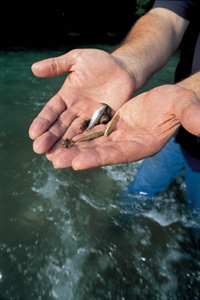Conservation Threats to Texas Water

The most significant conservation challenges to both freshwater and saltwater systems in Texas are reduced water quality and decreased water quantity.
Factors such as the increasing population, increasing demands for water and increasing shoreline development directly affect water quality and quantity.
Threats to Texas water
resources include:
Reduced Water Quantity - As the population grows and water demands increase,
water flow in rivers and streams, or instream flow, may decrease. Decreased
or altered water quantity will affect the ecosystems, habitats and wildlife
that depend on Texas streams and rivers. Increasing the demand for available fresh water, such as pumping out groundwater, building more reservoirs that alter water flow and water diversions make rivers,
streams and springs and the fish and wildlife resource they support exceptionally
vulnerable to the effects of drought. The health of aquatic and terrestrial systems, fishing and recreation in addition to agricultural, municipal, and industrial needs, depend on sufficient, quality freshwater runoff from land into rivers, streams, springs and reservoirs.
Reduced Water Quality - Point source and nonpoint source pollution threaten
native fish and wildlife species that rely on clean water. Water that will
not support fish and wildlife will not support human needs either. In the
next decade, pollution in rivers and streams may increase to
a point where they have a detrimental effect on aquatic life including low
oxygen, harmful algal growth and fish kills. As the population grows and water demands and waste runoff increases, water flow in rivers and streams, or instream flow, decreases.
Reservoir Construction - TPWD recognizes that reservoirs are necessary to
store water for human water consumption, flood control and hydropower generation
and to provide public freshwater recreational opportunities. However, reservoir
development significantly alters the stream and river systems as well as the
bay and estuary systems downstream. Direct impacts of reservoir construction
are caused by inundation of the land which displaces wildlife and causes the
loss of terrestrial, wetland, riverine, riparian and bottomland hardwood habitat
types. Indirect impacts include reduction and/or alteration of downstream
riverine, estuarine, riparian, wetland and bottomland hardwood habitat types
which harm species that depend on them.
Introduced Species - Exotic plant and animal species that are introduced
either by design or by accident can cause unintended harmful consequences.
Exotic species may become invasive, spreading rapidly, displacing native species
and threatening community relationships that are necessary to sustain the
aquatic environment. Eighteen non-native fish species have been documented
in Texas as well as a number of snail and bi-valve species. Some have had
an extremely negative impact on native fish communities. Further, great effort
and financial resources have been expended to control invasive aquatic plants
such as water hyacinth, hydrilla and giant salvinia, which have negatively
affected native freshwater communities.
Navigational Dredging and Disposal
Altered circulation in the deep waters of the coast that result from channel dredging may increase the salinity of upper estuarine areas. Some dredging closes off traditional migratory passes for numerous saltwater species. In addition, disposing of dredged material in open water increases turbidity and covers bottom habitat, including seagrasses that are nursery areas for much of our seafood and saltwater sportfish.
Noxious Brush and Invasive Plant Species
Undesirable or noxious brush, woody and invasive plant species such as mesquite, saltcedar, Chinese tallow, prickly pear, condalia and ashe juniper absorb vast quantities of water and provide little or no forage (food source) for wildlife or livestock. Many of these plant species are present in excessive quantities on rangelands in Texas today and through improved range management techniques, can be significantly reduced or controlled to benefit water quality and quantity as well as wildlife habitat.
Bycatch and Commercial Trawling
Some commercial fishing techniques can have negative impacts on fish species. For example, excessive bottom trawling can alter or damage important habitats, which can lead to a decline in overall fishing size and abundance, increase turbidity and put pressure on all marine species. Bycatch, or the catch of non-targeted species, from commercial trawling harms many other ecologically, commercially and recreationally important species.
Conservation efforts make a difference.
Communities, agriculture, industry, agencies and individuals are working together to minimize threats to our waters. What will you do to help conserve Texas' water resources? [more...]
[top]
|
